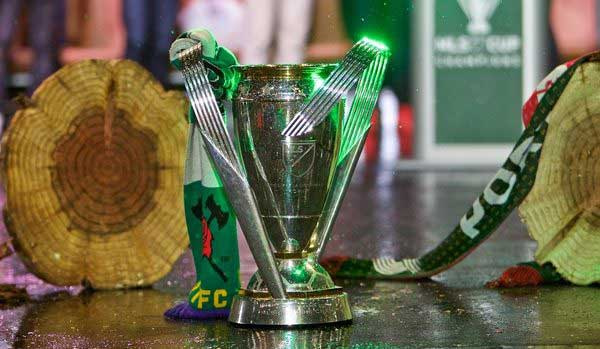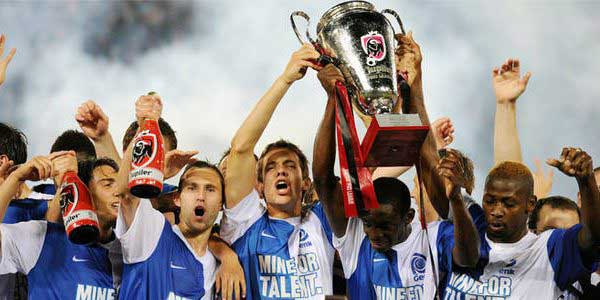According to news agency Reuters, approximately 60% of Brits know how the offside rule works in football.
However, there are some areas of the game that even the most enlightened of football fans struggle to comprehend.
Most football leagues around the world have a straightforward competition in which each team plays each other twice.
The team with the most points is eventually crowned champions and everyone knows where they stand.
It is often referred to as the 'European' format and works well for the English Premier League, German Bundesliga, French Ligue 1 and many other top leagues.
However, not every football league has decided to adopt such a simple approach.
Take Liga MX, Mexico’s top flight, for example, where the system known as 'Apertura and Clausura' is used. This format sees the season divided into two tournaments, in which each team plays each other just once in each half.
At the end of each tournament, the top 8 sides advance to a knockout competition, with the eventual winner crowned champion, which results in two champions per season.
While Apertura and Clausura is very popular in Latin America, there are other unusual football league formats which will leave you scratching your head!
Dutch Eerste Divisie
The Eerste Divisie is the second tier of the Dutch football league system and it offers one of the most unusual league seasons in football.
All in all, 20 teams enter the season in August with the hopes of securing promotion to the Eredivisie by finishing first in the league table.
It may sound familiar, but when the regular season comes to an end in May, things get a whole lot trickier.
The team that finishes in first place is guaranteed automatic promotion to the top flight.
However, the teams that fail to clinch the top spot must compete in a knockout tournament for the chance to enter the Eredivisie in the following season.
This would be fairly straightforward if the tournament was played between the top four teams, like the play-off system used in the lower leagues of English football, but it isn’t.
The top 4 sides do go through, but they aren’t alone.
The tournament sees 10 teams compete in total, with the top 4 joined by teams that are awarded places depending on how they do in particular sections of the seasons.
These are known as 'Periodes'.
- The team with the best record after 9 matches.
- The team with the best record between matches 10-18.
- The team with the best record between matches 19-27.
- The team with the best record between matches 28-38.
Most often this sees the best 8 teams enter the tournament.
However, that isn’t always the case. The 2013/14 season, for example, saw Sparta Rotterdam qualify despite finishing in 16th place, just 4 places off of the bottom.
The final couple of places are taken up by the bottom two clubs in the Eredivisie, who have the chance to fight to keep their place in the top flight.
The 4 teams that qualify via the regular season ‘Periodes’ enter the first round, with two teams qualifying for the second.
They then face off against the other 6 teams, with the 4 winners entering two finals, which decide who takes the two promotion spots.
The format is fairly straightforward, yet the way in which teams are selected for the promotion tournament is somewhat odd, if not extremely pointless.
What is Dutching? Well, firstly it has nothing to do with the Netherlands! Here is our complete guide to Dutch betting, including a FREE Dutching calculator.
North American Major League Soccer
While we’ve had enough time to get our heads around the format of MLS, it still offers a level of confusion to those that are unfamiliar with the league.
It sits somewhere between the Apertura and Clausura system and the standard, European system that we are used to.
The regular season consists of not one, but two tournaments, known as ‘conferences’ in which 10 sides compete in each.
These two conferences are known as ‘Western’ and ‘Eastern’ that split teams based on their geographical location.
Each team plays 24 matches against teams in their conference, as well as 1 game against each of the teams in the other conference.
This ‘regular season’ runs between March and October, before the two tables are combined to determine the winner of the ‘Supporters’ Shield’.
This is awarded to the team with the highest point total.
However, the Supporters’ Shield isn’t the main prize. Every team wants to get their hands on the MLS Cup, which is competed for once the regular season comes to an end.

The top 12 MLS teams compete for the MLS Cup, the league's top prize.
After a short break, the top 6 teams from each conference begin a knockout tournament.
Those ranked third to sixth must play a qualifying round, before moving onto a conference semi-final and conference final.
That leaves one final team from each conference to play the grand final. The MLS Cup Final is the pinnacle of North American football.
However, the strange progression to the final means that it more often than not isn’t actually contested by the league’s best teams.
For example, the 2012 MLS season saw LA Galaxy crowned MLS Cup champions, despite finishing in eighth place in the regular season’s combined table.
The 10 month European football season is considered the norm, but the Apertura and Clausura system used in South America provides an exciting alternative.
The Isles of Scilly Football League
This one isn’t complex or confusing. It’s just Scilly... and literally, too. And two.
You may recognise the name of the league from a Adidas advert ran back in 2008.
The likes of David Beckham, Steven Gerrard and Patrick Vieira turned up to a youth training sessions on small island, which boasts a population of just 1,000 people.
The Isles of Scilly Football League is significant because it is widely regarded as the smallest football league in the world.
There are just two competing teams in the competition - the Garrison Gunners and the Woolpack Wanderers.
These two sides play each other every Sunday over the course of the season, playing a total of 17 games throughout.
There's just one football pitch on the island, so every game is at home for both sides.
Better yet, there are also two annual cup competitions - The Wholesalers Cup and the Foredeck Cup, while the season is also opened with two of the league's sides competing for the Charity Shield.
The teams selected to compete for the shield are the previous season’s league winner vs the previous season’s cup winner.
If the same side won both the league and the cup then the runner-up qualifies. As I’m sure you’ve guessed, this is always Garrison Gunners vs Woolpack Wanderers!
The two-team competition has been going strong since the 1950s. However, there is a concern that it is on its last legs.
A large number of the Isles of Scilly’s young population are heading off to England to complete their education (as there is nothing beyond a secondary school on the island),
The average age of both teams is reaching the mid to late 30s, with both clubs struggling to replace their ageing stars.
Goal Profits Academy is our complete football trading course. Learn how to trade, based on proven methods that we’ve been using successfully for many years.
Scottish Premiership
When the addition of St. Mirren and Dunfermline took the total number of teams in the Scottish top flight to 12 back in 2000, the Scottish Premiership faced a tough decision.
Adopt the gruelling 44-game schedule that had been used in the previous top flight competition, or come up with something different.
The league opted for the latter and soon came up with a format that would see each club play a total of 38 games each year.
Much of the season uses the standard format, with each team competing in a standard table competition, trying to gain as many points as they can.
They each play each other a total of 3 times, with sheer luck deciding whether they get the advantage of playing two home games.
Once all of these games have been played, the season then splits in half, with the top 6 teams and the bottom 6 teams dividing off into two tables.
As a result, the top 6 cannot slip into the bottom half of the table and the bottom 6 can’t climb above 7th, which often results with teams with higher points totals placing below teams with lower tallies.
Following the split, each team then plays against the 5 other teams in their half of the table to decide the title victor and relegated side.
Scottish football isn’t alone in it’s use of this odd system.
Their United Kingdom neighbours, the Welsh Premiership, use a similar format, with its 12 teams playing each other twice in each campaign, before splitting off into two 6-man leagues to decide the season’s winners and losers.
However, it doesn’t end there. The title winners gain a place in the Champions League and second placed make the Europa League.
Those that finish in 3rd to 6th, as well as the top placed team in the bottom half league, then compete in a play-off tournament to decide who gets Wales’ second Europa League spot, before a long, drawn out season finally comes to an end.
Correct score trading on Betfair is exciting and profitable! Learn how to predict correct scores and profit with easy-to-use football trading strategies.
Belgian First Division A
The Belgian First Division A, better known as the Jupiler Pro League, sees its 16 teams play in a standard ‘regular’ season throughout the majority of the campaign.
Each team plays one home and one away game against each of their rivals throughout the campaign, trying to notch up as many points as they possible can.
Once every game has been played and the standings are confirmed, the table is then split into two play-off categories.
Strangely, at this stage the points total of each team is split in half with half-points rounded up to the nearest whole number.
This is done in order to close the gaps between teams and increase the competitiveness of the play-offs, but it is a kick in the teeth to the sides that performed so well throughout the regular season.
The top 6 sides enter the ‘Championship’ play-off, where they face one another two more times in order to determine the title winner.
Those placed 7th to 15th compete in another play-off, with the winner gaining a place in the following season’s Europa League competition.

Genk emerged victorious from the Championship play-off in 2011/12.
Until recently the Belgian top flight featured a third play-off between the bottom two clubs, in which they would play each other a total of five times to decide who stays up and who goes down.
However, a reshuffle of Belgium’s football pyramid saw that scrapped.
The team that finishes in 15th now join the second play-off group and the team in 16th place suffer automatic relegation.
This is definitely an unusual football league format!

